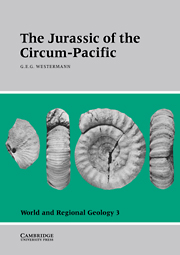Book contents
- Frontmatter
- Contents
- List of contributors
- Preface
- Acknowledgments
- Introduction
- Part I Time scales
- Part II Circum-Pacific base map
- Part III Regional geology and stratigraphy
- Part IV Biochronology
- 12 Ammonite zones of the circum-Pacific region
- 13 Jurassic palynomorphs of the circum-Pacific region
- 14 Radiolarian biozones of North America and Japan
- 15 Ostracods of western Canada
- 16 Bivalve zones and assemblages of the circum-Pacific region
- 17 Belemnites of the southwest Pacific
- Part V Biogeography
- Part VI Climatology and oceanography
- Appendix: Biochronology and atlas with index and guide fossils
- General Index
- Index of Guide- and Indexfossils
14 - Radiolarian biozones of North America and Japan
Published online by Cambridge University Press: 04 August 2010
- Frontmatter
- Contents
- List of contributors
- Preface
- Acknowledgments
- Introduction
- Part I Time scales
- Part II Circum-Pacific base map
- Part III Regional geology and stratigraphy
- Part IV Biochronology
- 12 Ammonite zones of the circum-Pacific region
- 13 Jurassic palynomorphs of the circum-Pacific region
- 14 Radiolarian biozones of North America and Japan
- 15 Ostracods of western Canada
- 16 Bivalve zones and assemblages of the circum-Pacific region
- 17 Belemnites of the southwest Pacific
- Part V Biogeography
- Part VI Climatology and oceanography
- Appendix: Biochronology and atlas with index and guide fossils
- General Index
- Index of Guide- and Indexfossils
Summary
The correlation chart presented herein (Figure 14.1) was compiled through a critical examination of published and unpublished data for both Japan and North America. Because of the vast amount of unpublished data from both North America and Japan, it was first necessary for the authors to meet and to examine hundreds of scanning electron photomicrographs of North American and Japanese Radiolaria. Without such a meeting, any attempt at correlating North American and Japanese Jurassic radiolarian biozones would have been, at best, an exercise in futility (plates 99–102).
The radiolarian zonation for North America followed herein represents an emended version of that presented by Pessagno et al. (1987b). The North American zonation shown in Figure 14.1 is the result of over 10 years of field and laboratory investigations by Pessagno and his associates. North American Jurassic samples were analyzed from Alaska, the Queen Charlotte Islands (British Columbia), east-central Oregon, California, Baja California Sur, and east-central Mexico. In establishing a zonal scheme for the North American Jurassic, Pessagno et al. (1987b) calibrated the radiolarian biostratigraphy with those of the ammonites, calpionellids, Buchia, and other well-studied fossil groups. This amalgamation of data allowed a fit of the radiolarian zonation to the ammonite-based chronostratigraphic scale. Figures showing the approximate correlation of radiolarian zonal units with ammonite standard zones were presented by Pessagno et al. (1987b) and are not included here.
- Type
- Chapter
- Information
- The Jurassic of the Circum-Pacific , pp. 293 - 295Publisher: Cambridge University PressPrint publication year: 1993
- 2
- Cited by



